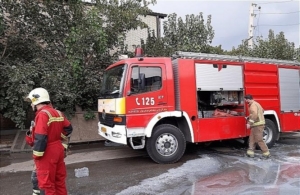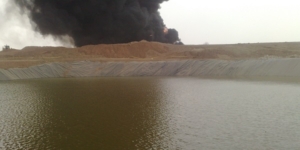Fire Pool
Fire pool ponds are water pools that are used to prevent the spread of fire and to provide the water needed to extinguish a fire. They are especially important in rural areas and areas with a high risk of fire where access to fire hydrants and pipes is not easily accessible.
The pools target homes, farms, industrial facilities, oil and petrochemical refineries, and agricultural centers and fields that are at risk of widespread and devastating fires.
Also, due to fire ash and the release of carbon dioxide from burning, air quality is reduced, which can affect the environment and the lives of people living around the fire areas.

Therefore, putting out fires as soon as possible can reduce a lot of environmental damage. One of the advantages of fire pools is the rapid supply of water to extinguish the fire.
The effects of the fire are harmful to many, including residents of rural areas and industrial centers. Without firefighting facilities and pipes, firefighters in small towns and rural areas will not be able to provide the water resources needed to contain the fire.
Although they may have fire-fighting equipment, machinery, and pumps, all of this equipment would be worthless without a nearby water source. For this reason, today, it is very important for many communities to build a fire pool and pool where firefighters can use the water to put out fires.
The size of the pools depends on the amount of water it needs to hold, which depends on the extent of the potential fire extinguishing range. For example, for 200 square meters of building infrastructure, a pool with a capacity of 15 cubic meters of water is needed.
These pools are not only used for fire control and can have other applications such as beautification, agriculture, recreation or other purposes.
The things that should be considered in order to maintain fire pools are as follows: As much as possible, the water of these pools should be away from grasslands and algae so as not to disrupt the operation of the pump.
Fortunately, there are enzymes that prevent the growth of algae that can be used to control the growth of algae. Also, its water must be frozen in winter. In addition, the piping system should be checked periodically for the absence of mud and grass.

Application of geomembranes in the construction of fire pool
The first step in building fire pools is their location, shape, size and depth. In some US states, the minimum size for such pools is one hectare. These pools can be built in different ways according to site conditions and engineering considerations. Today, the use of geosynthetic materials such as the family of geomembranes to build these pools is growing.
Geomembrane is a flat and relatively impermeable plate made of very low permeability polymeric material that acts as a highly durable insulator. Geomembranes are impermeable coatings that are highly resistant to corrosive chemical agents.
These impermeable sheets have different properties depending on the type of polymer used in their construction.
Advantages of geomembranes
The advantages of building fire pools using geomembranes include the following:
High flexibility
High safety and non-harmful to aquatic animals, plants, algae and other living organisms
Can be made in different shapes, dimensions and depths due to its ductility
Quick and easy installation
High durability
No need for complex and special infrastructures
Resistant to hydrocarbon attacks
Ability to separate the torn part
Suitable for high hydrostatic pressure
Very resistant in connection areas
200 to 300% long length change


